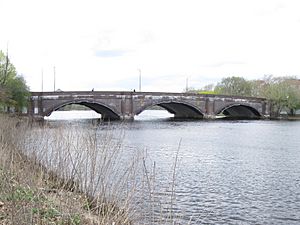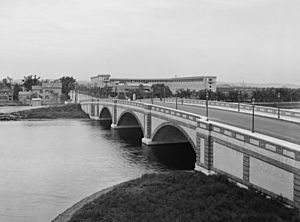Anderson Memorial Bridge facts for kids
Quick facts for kids Anderson Memorial Bridge |
|
|---|---|

The Anderson Memorial Bridge in April 2011
|
|
| Coordinates | 42°22′08″N 71°07′24″W / 42.3689°N 71.1232°W |
| Crosses | Charles River |
| Locale | Cambridge, Massachusetts to Boston, Massachusetts |
| Maintained by | Massachusetts Department of Transportation |
| Preceded by | Great Bridge (Cambridge) (1662) |
| Characteristics | |
| Design | arch bridge |
| Material | reinforced concrete faced with red brick |
| History | |
| Designer | Wheelwright, Haven and Hoyt |
| Construction begin | 1913 |
| Construction end | 1915 |
| Lua error in Module:Location_map at line 420: attempt to index field 'wikibase' (a nil value). | |
The Anderson Memorial Bridge connects Allston, a part of Boston, with Cambridge. This bridge crosses the Charles River. It is built where the Great Bridge once stood in 1662. That was the very first bridge to cross the Charles River! The Anderson Bridge helps traffic from Boston (North Harvard Street) get to Harvard Square (via JFK Street). It was completed in 1915.
Contents
Why the Bridge is Named Anderson
Many people think the bridge is named after Larz Anderson. But it was actually built by him to honor his father, Nicholas Longworth Anderson. Nicholas was a brave general in the United States Army during the American Civil War. Larz Anderson used a lot of money from his wife's family, the Weld Perkins fortune, to build this special bridge.
In 1913, the Metropolitan Park Commission explained that the new Anderson Memorial Bridge replaced an old, weak wooden bridge. They said it was possible because of Larz Anderson's generous gift. It was a way to remember his father, a "gallant general" known for his role in the Civil War.
How the Bridge Was Built
The bridge was designed by a group of architects called Wheelwright, Haven and Hoyt. The building work was finished under the guidance of John R. Rablin. He was the chief engineer for the Metropolitan District Commission.
Bridge Improvements
From 2012 to 2016, the MassDOT (Massachusetts Department of Transportation) worked on the Anderson Memorial Bridge. This project cost about $25 million. They fixed the arches and replaced parts like the walls, sidewalks, lights, and the bridge's top surface. Now, the bridge has three lanes for cars (two going north and one going south) and a special lane for bicycles.
What Makes the Bridge Special
The Anderson Memorial Bridge is made of strong concrete with red bricks as decoration. The walls and panels of the bridge are shaped to look like rough stone. Its design is called Georgian Revival with some neoclassical touches. This helps it blend in with other bridges over the Charles River and the buildings of Harvard University nearby.
An author named Douglas Shand-Tucci wrote about the bridge's design. He mentioned that it uses a special mix of concrete walls with red brick decorations. This style was also used for Harvard's sports buildings. The bridge also has fancy, golden decorations on its entrance piers at both ends. These decorations were made by a famous sculptor named Johannes Kirchmayer.
A bronze plaque on the Cambridge side of the bridge explains its meaning. It says: "May this bridge, connecting the College Yard and playing fields of Harvard, be an ever present reminder to students passing over it of loyalty to country and Alma Mater." This means the bridge is meant to remind students to be loyal to their country and their university.
The bridge is right next to the Weld Boathouse. It was designed with a high arch. This high arch allows all kinds of small boats to pass underneath easily. Both the bridge and the boathouse (built in 1906) were paid for by the family who inherited money from a rich person named William Fletcher Weld.
Images for kids



